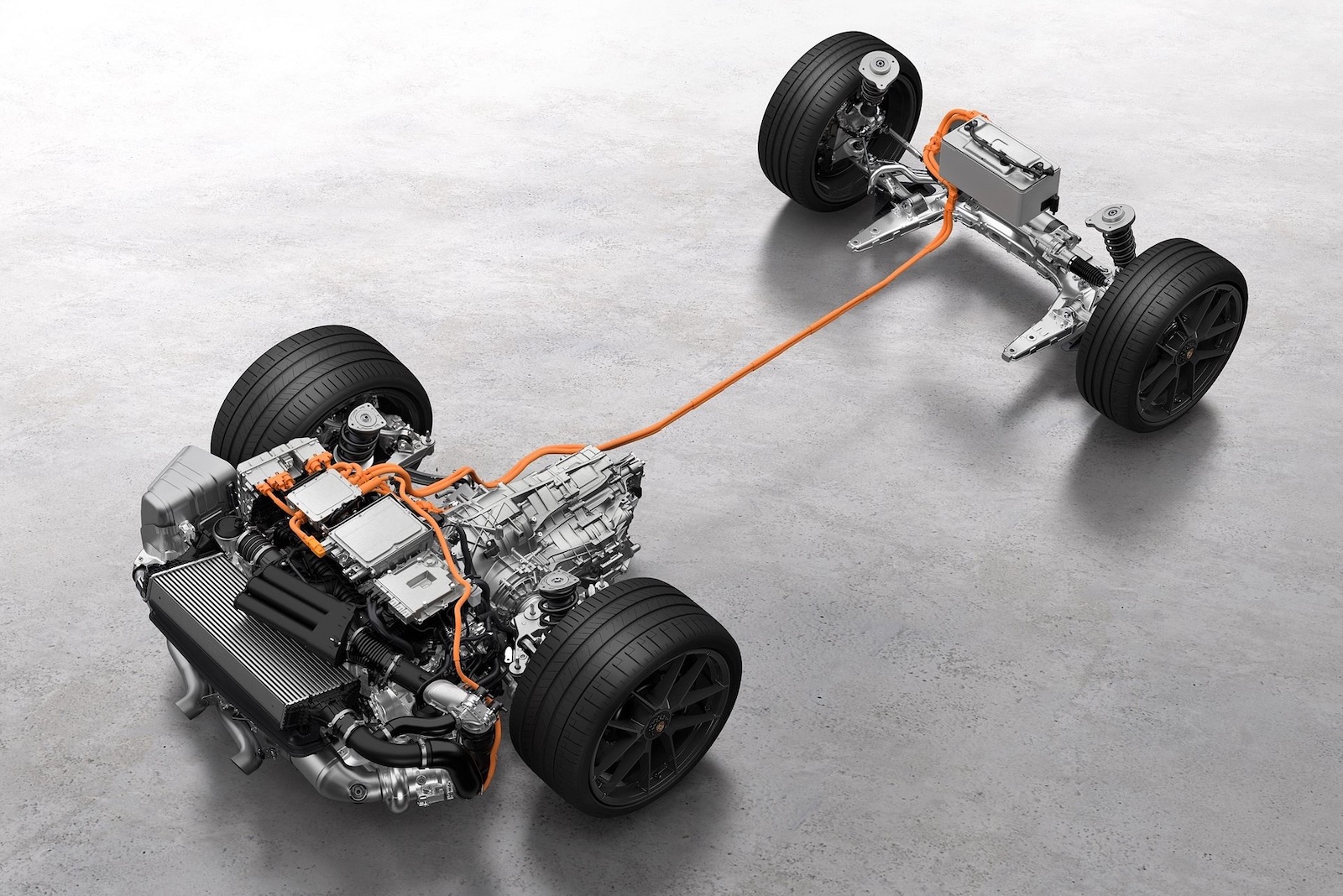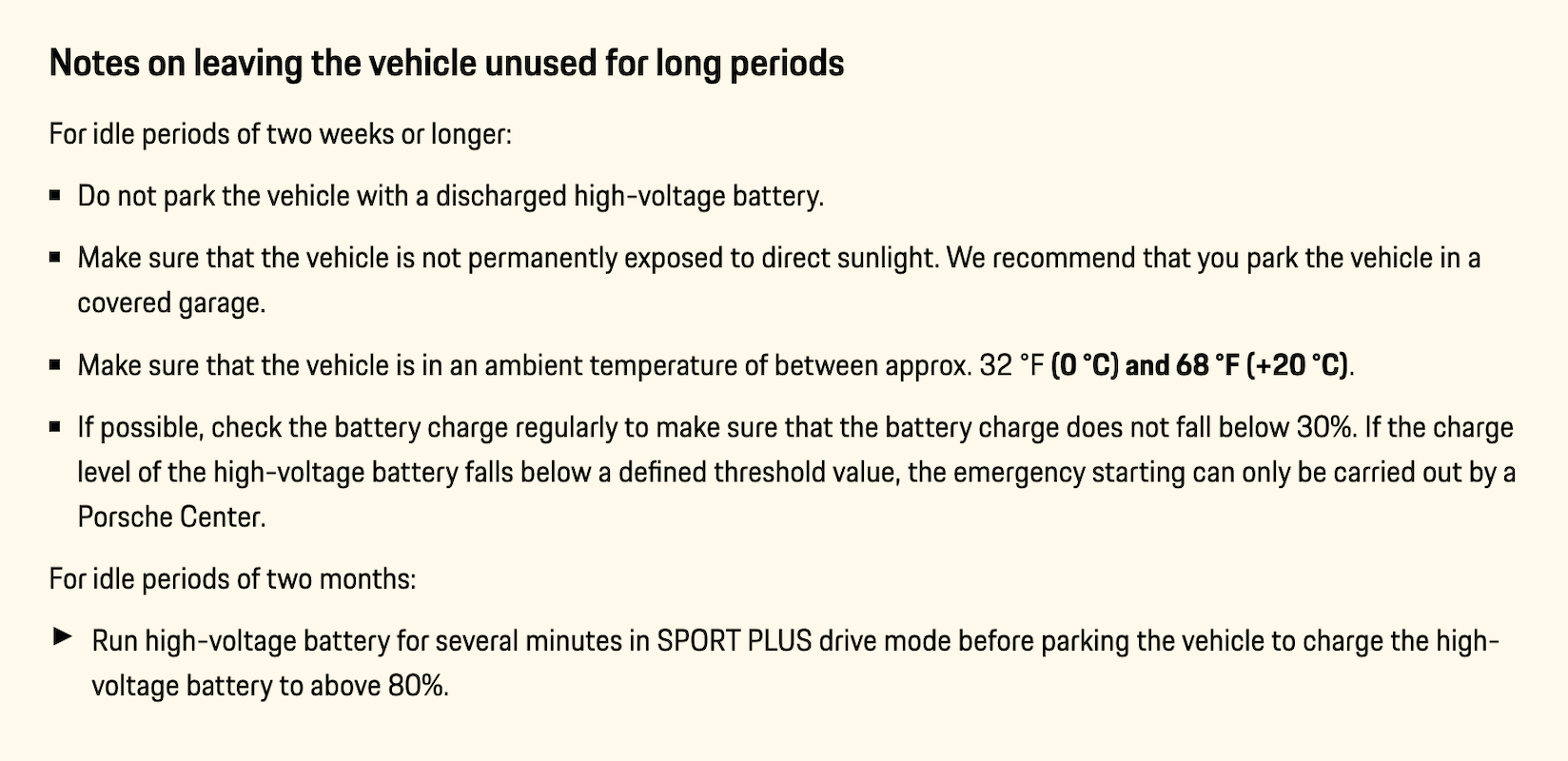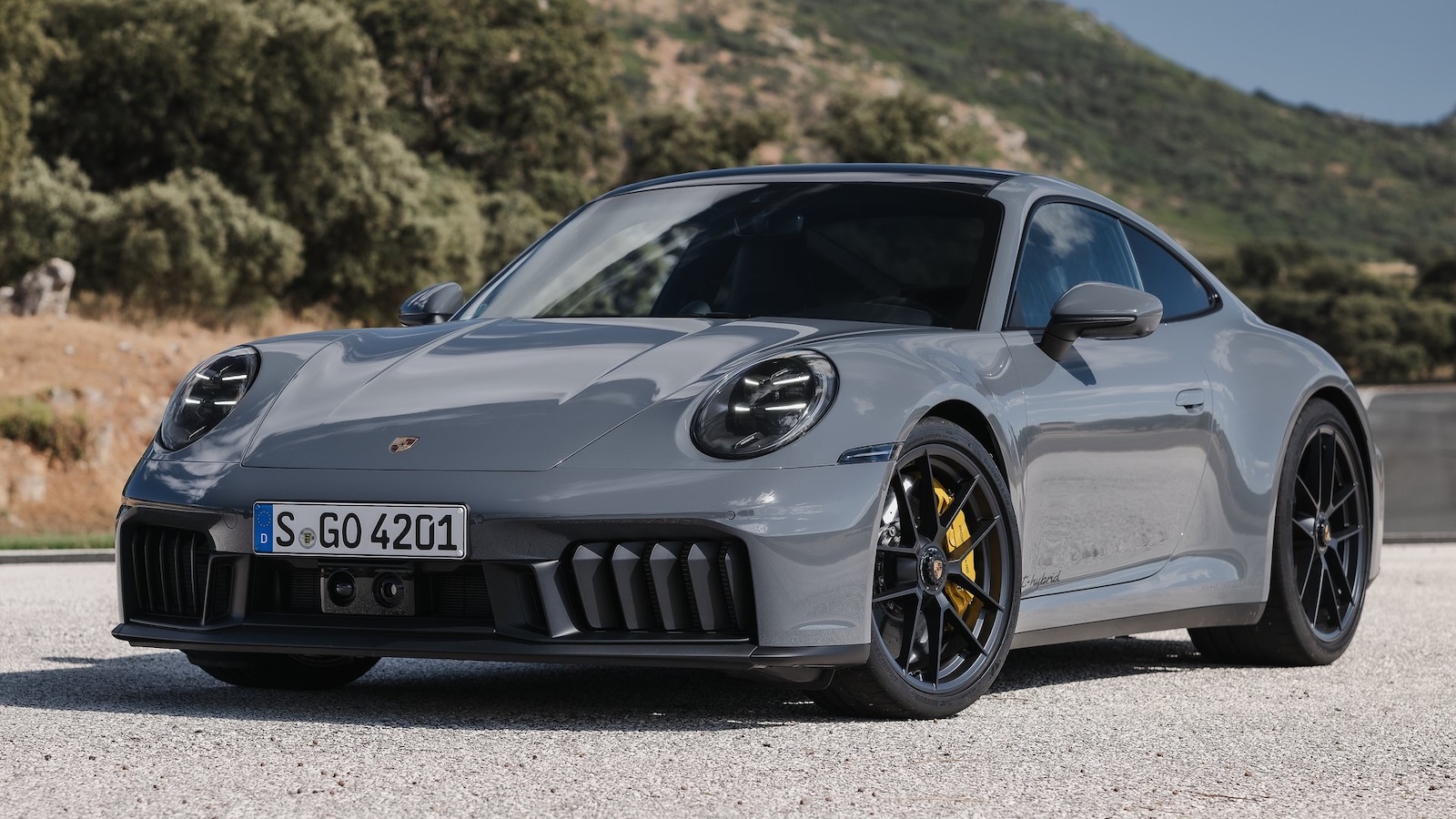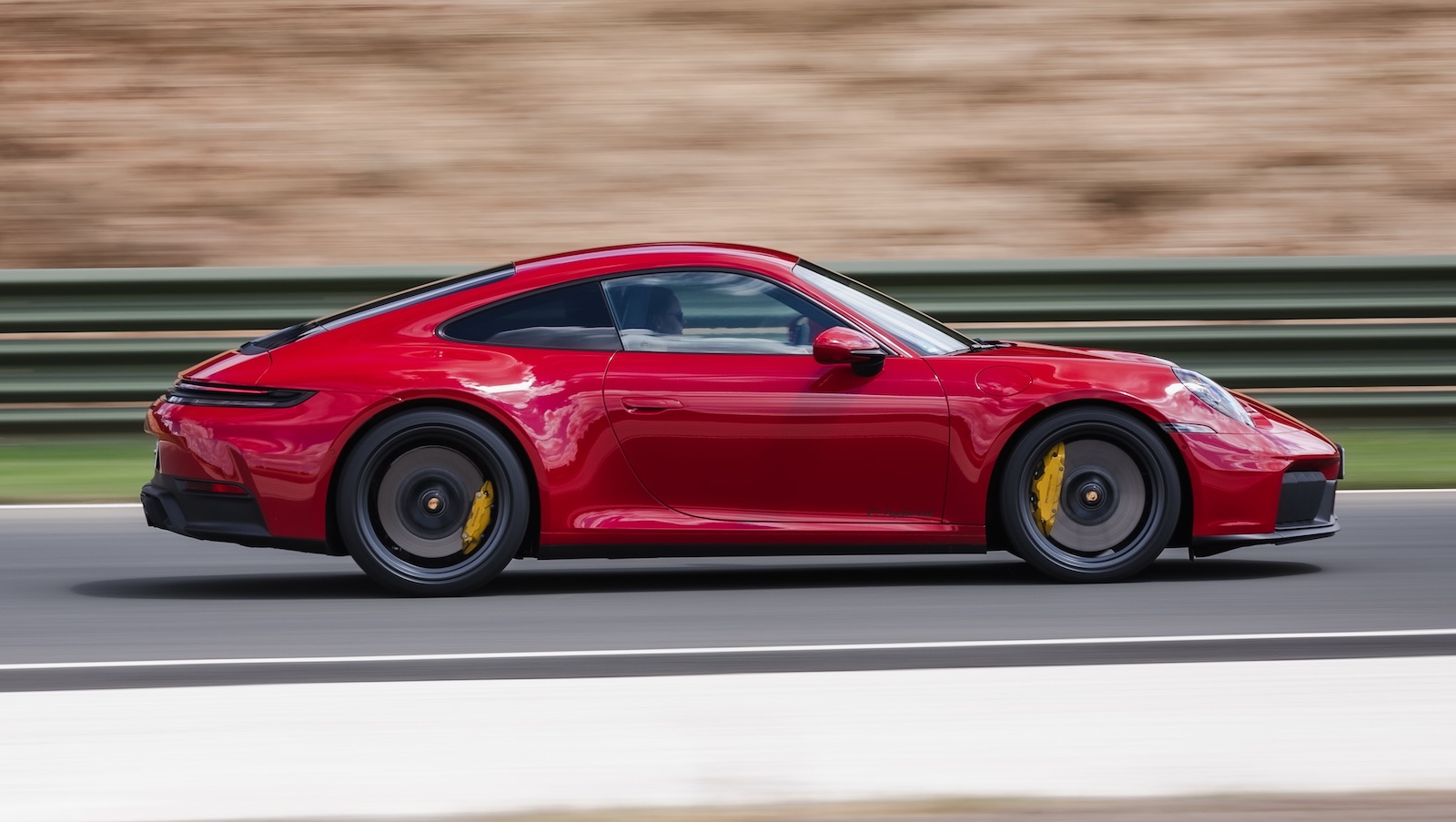The new Porsche 911 Carrera GTS T-Hybrid is pretty amazing when you think about it. It works unlike pretty much every other hybrid system on the market, using electric assistance to boost output rather than to embrace the quiet glide of an electric motor around town. Unfortunately, sports cars like a 911 are often occasional drivers, and this powertrain doesn’t seem to be set up optimally for what that use case might entail.
First, some background on what makes the new GTS trim special. A flywheel motor augments a 3.6-liter flat-six with an electrified turbocharger to crank out a combined 532 horsepower and 449 lb.-ft. of torque, resulting in a real-world zero-to-60 mph time in the mid-twos, modern emissions compliance, and a relatively modest 60-pound weight penalty. Better yet, the 1.9 kWh high-voltage battery pack sits in the normal battery tray, meaning you aren’t giving up any trunk space.
However, if you want to tuck your new 911 Carrera GTS T-Hybrid or 911 Targa GTS T-Hybrid away for an extended period of time, there are some precautions you should be aware of. I went poking through the owner’s manual and found these precautions listed, which led Matt to say that the car is “basically a Dracula.” You’ll see what he means.
Notes on leaving the vehicle unused for long periods
For idle periods of two weeks or longer:
- Do not park the vehicle with a discharged high-voltage battery.
- Make sure that the vehicle is not permanently exposed to direct sunlight. We recommend that you park the vehicle in a covered garage.
- Make sure that the vehicle is in an ambient temperature of between approx. 32 °F (0 °C) and 68 °F (+20 °C).
- If possible, check the battery charge regularly to make sure that the battery charge does not fall below 30%. If the charge level of the high-voltage battery falls below a defined threshold value, the emergency starting can only be carried out by a Porsche Center.
For idle periods of two months:
-
Run high-voltage battery for several minutes in SPORT PLUS drive mode before parking the vehicle to charge the high-voltage battery to above 80%.
There’s a lot to unpack here, so let’s start from the top. Obviously, letting anything with a battery sit discharged for a while isn’t great for battery health, whether we’re talking about an iPod Shuffle or a car. Ever try to power up one of your old mobile phones for nostalgia’s sake, only to find it doesn’t hold a charge?

However, the next few clauses seem absurd. If you’re parking your 911 Carrera GTS T-Hybrid for two weeks or more, you can’t leave it in direct sunlight and can’t let it get too hot or too cold. Probably not the best machine to leave at the airport while away on a two-week holiday, then. However, even if you take sunlight out of the equation, many residential garages get above 68 degrees Fahrenheit in summer and, if you live far enough north, below 32 degrees Fahrenheit for weeks in the winter. This seems like a tricky limitation for those who store their cars out of the snow in winter, but it’s fixable with climate-controlled storage. The next item? Not so much.

Basically, whether you’re leaving the new 911 Carrera GTS T-Hybrid parked for two weeks or two months, the state-of-charge on the hybrid battery must stay above 30 percent as per Porsche’s instructions. So what about just throwing the 911 Carrera GTS T-Hybrid on a trickle charger? Well, that will keep the 12-volt battery topped off, but it’s not going to feed the high-voltage pack. Even if it could, Porsche’s own trickle charger, along with many on the market, has a maximum DC output of 14.7 volts and five amps. That’s 73.5 watts, not nearly enough to provide meaningful juice to a high-voltage hybrid battery pack.

While it is totally possible to idle the engine in Sport Plus mode to replenish charge, idling without driving requires a bit of care. Not only should the space you start the car in be well-ventilated to avoid carbon monoxide poisoning, you also need to ensure the oil reaches a hot enough operating temperature to get rid of condensation. Ever lift the oil cap on a car that’s done a lot of short trips to find milky residue under the cap? That’s an effect of condensation in the oil.

Now, if you ignore these precautions and let the state-of-charge in the hybrid battery pack get critically low, there’s a chance you won’t be able to start your 911 Carrera GTS T-Hybrid. That’s because it uses the high-voltage electric motor inside the bellhousing to start the engine instead of a traditional 12-volt starter motor. This means that instead of a traditional jump-start, you’ll be calling a flatbed to take your car to the dealer for an emergency start. I suspect this is partly why models like the McLaren Artura and Ferrari 296 GTB are plug-in hybrids. They’re occasional-use cars, and if electrification is the solution to meeting both performance targets and emissions targets, why not let these cars be topped off from the mains?

There is one solution to managing the high-voltage battery charge in the 992.2 Porsche 911 Carrera GTS T-Hybrid, however, and that’s by making it your daily driver, and throwing the keys to trusted close friends and family when you go on vacation. Sure, if you live in a place that salts the roads, winter will treat the underbody with indiscriminate hostility, you will get rock chips, and there’s a chance you won’t end your ownership period with a clean Carfax, but do you know what they call the person with the most mileage on their sports car? A hero.
Top graphic image: Porsche
Support our mission of championing car culture by becoming an Official Autopian Member.









“ Even if it could, Porsche’s own trickle charger, along with many on the market, has a maximum DC output of 14.7 volts and five amps. That’s 73.5 watts, not nearly enough to provide meaningful juice to a high-voltage hybrid battery pack.”
Even from 0-100% that’s just over 1 day to charge a 1.9kWh battery, so not sure how that’s not “meaningful”.
It’s never going to be dead, and only needs to be maintained at 80%, so realistically would begat less time.
Doesn’t sound like Porsche thought this one through, or rather they did but couldn’t be bothered coming up with an acceptable solution.
Porsche doesn’t expect anyone to actually follow this recomendation. It’s printed in the owners manual for warranty liability. When the battery fails early (it will) they just tell the customer it failed because you didn’t follow the owners manual. Then deny the claim and the customer has to pay for the battery. Lots of manufacturers do this.
I bet many garages in Dubai are air-conditioned specifically for this car.
Another reason why hybrid technology is stupid. I want a car that I don’t have to follow mind-numbingly specific procedure or deal with the complexity and weight.
Es lebe ICE!
is your actual argument that “don’t let the battery discharge all the way” is mind-numbingly specific, but “keep up with maintence intervals on half a dozen fluids and dozens of moving parts” is trivial? The electric part of any hybrid system is exponentially less effort to maintain than the ICE part. It’s basically the equivalent of “don’t let gas sit for years in the tank” and that’s the whole maintenance program for the hybrid system!
Nah park it with the Camels in the AC barn
All super cars of every generation are very complex and require special care. Then the tech gets refined and trickles down and becomes less of a hassle. Also not like regular hybrids have this issue, no one is freaking out about Prius maintenance.
This sort of hurts. I live in a cooler climate and my garage temperature has yet to top 59F. In the winter, it tends to level off at 8F. I heat to working side of my garage when I am at home, and otherwise let it decay. On the daily driver side, it stays cold for 1.) Corrosion prevent and 2.) Environmental/energy reasons. I have Lithium Iron Phosphate Batteries that I store at 0F or colder. They have internal heaters to keep them happy.
I just feel a sense of irony that many of these cars will be owned by people in northern climates who are snow birds. They will heat their garages all winter long, and cannot claim it is solar because there is no solar in the winter. This is all to make a car that has a lesser impact on the climate because it consumes less fuel?
I don’t think the typical buyer of this car who lives in the north and drives their giant RV to the Villages gives two shits about this, but I’m surprised Germany has not jumped on the irony of these storage requirements. As they say: “there should be a law against this”
Within my lifetime, our German “Green Party” has moved from getting into fist fights with the cops over airport expansion project to pandering to the uneducated left while fucking over consumers and ignoring actual environment issues.
They’ll tell you to wear a sweater at home in the winter so you don’t have to turn on the heating but happily ignore Mercedes (the company) pushing 4-ton-“hybrid” SUVs and rich people taking private planes from one city to the next.
My favourite Green Party moment was when gas prices spiked after the whole Ukraine situation started and one of their people was like “well if you can’t affort 2€/liter for gas then just buy an electric car lol” … I’ll leave comparisons to historical people who said stuff like that and how it turned out for them to your own imagination.
Let them eat cake
God forbid you feed the car after midnight or get water on it.
EV is supposed to be less maintenance than ICE
Porsche: hold my beer
You know, that makes sense. The heat is what killed all the (kept outside) Leafs in California.
Poor engineering and lack of thermal management killed the Leafs.
Porsche left off the most important rule:
most EVs probably have similar requirements for long term storage. Volvo lists: Keep in a cool place or shade, have the battery charged in the 40-60% range, etc
Probably so another reason to scrap EVs and taxpayer funded bogus funding
I wonder if making it a plug-in hybrid would change some legal classification for the car. Because it sound like there’s no other reason to not install a HV charging port.
68 °F max temperature??
It’s warmer than that in my office right now by about 10 degrees.
Insane. Why not just light it on fire and get it over with. (slight exaggeration)
Are these “requirements” because of the battery location? Or why Toyota is not that particular with this? If you have Porsche money that means you have some sort of garage available.
Hybrids rule! ICE DROOLS!
Do the happy owners have to tuck their hybrid Porsches in at night? Read them bedtime stories?
I’m not really seeing the insane here. If you aren’t going to drive it, then check the charge every couple weeks, top it up first if you’ll be parking it longer. The only thing that really gives me pause is keeping it below 68°, which to me sounds EXTREMELY cold for a garage of any kind– I don’t even let my house get that cold– but maybe even that’s no big deal for someone in this car’s target demographic.
Where I am, those are “springtime” temperatures. Winter is 0F (but for global warming, that’d be -10F), summer is up to 95F, though at night it’ll probably cool down to 75 or so. Inside my house it’ll probably be 55-60 (winter) to 75-85 (summer), so bringing it indoors wouldn’t help in the summer. Guess I shouldn’t get one to replace my Soul.
Geez, as a Phoenician these are impossibly low numbers. My garage self-heats to 120°+ this time of year.
Anyone bewildered by suggestions to park it in your garage when so many EVs with the spontaneous cumbustion problem say do not park it inside. And isn’t it time if we call gasoline cars internal combustion we start calling EVs Spontaneous Combustion Engines?
Just provide an HV charger for God’s sake. I expect most that can afford these new have climate controlled garages. It will the the second/third owners for whom things will get interesting.
From experience… open garage door, idle for ~40 minutes. After its warmed up a fair bit (oil temp > 150F), put it in neutral and cycle in some sustained load. Like, bring it to 2000 to 3000 rpm, let it sit and fluctuate in that range a bit, back to idle, repeat.
When you turn it off, usually want the oil temp above 190F. Even the spiciest stuff they sell, driving it around very casually, it usually sits around 190-195F.
Though yes, this is enough to prevent condensation in the oil and exhaust pipes. This only needs to be done about every 4 weeks or so.
In other words Porsche is telling you to drive the car instead of being a garage queen
well, unless it’s over 70 out, then you should strap your portable AC to it.
Fail. This is ridiculous. More German overengineering.
This will be interesting for any Porsche dealer that deals with winter climates. Unless they plan to have them on the lot for less than 2 weeks at all times.
There’s not a ton of 911s sitting on most Porsche lots, and for where I’d expect to see enough of them, they’d be in warmer climates to begin with.
Around where I am, 911 GTSes would be a small subset of the few 911s they might have in inventory, so they’d just likely be parked in the showroom.
My understanding is that basically all the special 911s are custom order or dealer trade these days. If you happen to have one in stock it’s on the showroom floor behind a velvet rope, away from the Macan-buying plebs.
911 GTSes aren’t “special” 911s.
Of all the sports cars Porsche sells in the US, only about 1 in 3 are custom ordered last I checked (2023), the others are ordered by the dealership to put on the floor, usually with popular options that may or may not also be higher margin options.
Well, the ambient temperature in my garage is like 100 degrees for half the year, so no GTS for me. I guess I’ll just have to get a GT3 instead.
I can confirm hero status for daily driving a Porsche sports car. The indie shop near me and the dealer both treat me differently. And also complain about people flat towing their cars in for service.
It’s possible I’m misunderstanding the instructions, but it seems like for long term storage, they just want you to charge the battery to above 80% before putting the car away. Presumably that ensures it degrades to no lower than 30% over the winter, with no trickle charger needed.
I’m also not understanding the issue with the climate-controlled storage; possessing an attached garage is not a big hurdle for most buyers of a $150,000+ automobile. Anything on summer tires shouldn’t be stored under 32 degrees anyways. This isn’t some kind of new requirement; there’s a reason I keep the Viper in the garage in the winter and not in the barn.
This article seems to be applying shitbox ownership logic to a premium new sports car.
Except that many people have, and will continue to, buy a Porsche 911 as a daily. It will not be possible to use it in the winter if you can’t leave it parked in freezing temps.
You can, just not for multiple weeks without starting and running it to recharge the battery. Really only seems like an issue for stored cars.
Things have largely progressed past that point, and quite some time ago.
Now, stuff like Cup 2s or Cup 2 Rs? Yes, no sustained time in cold.
Something like a Pilot Sport 4S? PZero Z24s? They’re fine. I’ve been doing it for the better part of 20 years at this point. Now, I do put the car on Flatstopper ramps to prevent flatspotting, and I do roll it around a bit as well to further prevent any flatspotting. However, I do thoroughly inspect after winter, and especially after the first few post-winter drives, but most modern sports car tires are fine so long as your service life for the tire is 5 years or less from date of manufacture.
A lot of this is we’re in multi-compound tires anyways. The soft bit is more the outer tread blocks, where the inner is much more all-seasony.
The main issue of summer tires in actual cold temps is cold tires are cold. You have less grip than an all-season. You have to respect it, especially longer braking distances. Though in -5F air temps (-25F wind chill on highways) I’ve done the Christmas morning trip on Pilot Sport 4Ses for many years, and they’re fine.
Fair clarification. I had stuff like the former in mind as it’s what I run on the Viper.
What do you get for tire life out of the sticker stuff?
I got maybe 7K miles out of the rears for Pilot Sport 4Ses on a 981 Spyder, which was only 310lb-ft through 265s. Mind you, of my usual tomfoolery, 70% of the miles are cruising to “get to the fun roads” to really go nuts with it.
I’d only do “hero tires” if I was doing track days on the regular, and I’d probably have separate wheels to have them on. Otherwise I feel like I’d have to replace the tires nearly every year. So +25% cost for tires, and then replacing them at least twice as often. Right now it’s 330lb-ft through 295 rears, and with pipes and the thing set up for actual track work, it’d be 345-350lb-ft through 305 rears.
That and detached garage. No heat. It can be 10-15F warmer/cooler over just being completely outside, but for “hero tires” I’d need to either put the car up on a Bendpak QuickJack with the wheels off (stored in home), or second set.
10k miles more or less. Pirelli Corsa Systems. This set I’ll replace for age rather than miles as being more of a family man limits my opportunities to drive the car (and really limits track driving).
I bought an extra set when they went on clearance a while back, and they are now discontinued, so I’ll need to get something else next time.
They do make the PS4S in Viper sizes now, and I have them on my Blackwing, so I might just go with the same thing.
You may wish to consider the Continentals over the PS4S, depending on what you’re looking for in a tire.
The PS4S will be more pointy and immediate.
The Continentals are far more progressive right off center, better wet handling and hydroplaning resistance, more compliant, less noise. It’s a five year newer tire and it shows. It doesn’t have the absolute limits of the PS4S, but it’s splitting hairs a bit.
I put PS4S on the Spyder RS, but I put the Contis on the M156-powered C63. Given each car’s job, probably the right choice, but I wish there was a newer option for the SRS.
The houses in my neighborhood go for $1.2m+ these days, and while they all have attached garages, none of them have HVAC in them. I certainly didn’t see too many garages with HVAC when I lived back east, either.
My garage doesn’t have HVAC either but even at -10 outside it stays above 32 in there.
Okay but does it stay below 68F?
I only store cars in the winter though.
A lot of people are missing that the temp limits only matter if the car is parked for multiple weeks/months
Yeah, I saw the part about long term storage after I started the thread. Presumably if it’s hot, you’ll drive the thing.
Covered garage recommended. Oh, you don’t have a semi-detached and fully climate-controlled insulated garage? No Parsh for you! You come back, one year!
We could call this character the “Car Stickler” or maybe something a little catchier.
I mean, I have one of those. But I store a 320k mile 80s Mercedes in it.
Out of all the requirements, the temperature one is the most egregious.
My uncle in Phoenix had a 300k+ 1981 300D, and it definitely lived in the garage.
My first couple of Southern US summers with (modern) German cars made us all joke about how all their plastics and adhesives were made only for a German climate. Colder? It breaks. Warmer? It sags.
Car fascist?
Car guys who came up with the Volkswagen?